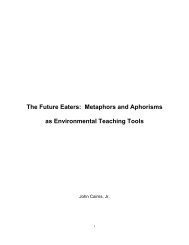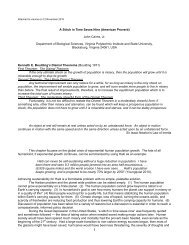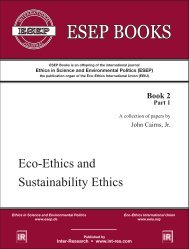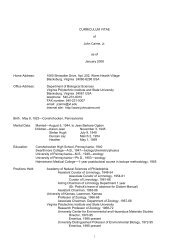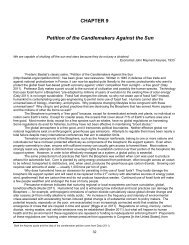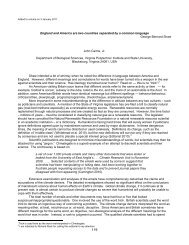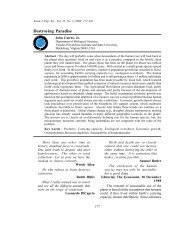You also want an ePaper? Increase the reach of your titles
YUMPU automatically turns print PDFs into web optimized ePapers that Google loves.
Attached to volume on 7 October 2008<br />
CHAPTER <strong>32</strong><br />
CO-EVOLVING WITH JEANNIE<br />
Since Jeannie is no longer with me, I have no choice but to describe the challenges we met together as I remember<br />
them. These incidences could have destroyed our relationship, but they strengthened it instead. Our children have been<br />
extremely helpful in recalling memories of the early days, and Kathy Brady (nee Osgood) has been an invaluable source of<br />
information about the early days at Penn State, where Jeannie and I first met. Reconstructing the past is extraordinarily<br />
difficult. Irving notes: “Your memory is a monster; you forget – it doesn’t. It simply files things away. It keeps things from<br />
you, or hides things from you – and summons them to your recall with a will of its own. You think you have a memory; but it<br />
has you!” (as quoted in Marcus 2008, p. 18). Also, Pinker remarks: “To a very great extent, our memories are ourselves” (as<br />
quoted in Marcus 2008, p. 36). “Yet memory is arguably the mind’s original sin. So much is built on it, and yet it is,<br />
especially in comparison to computer memory, wildly unreliable” (Marcus 2008, p. 36). These issues were particularly<br />
troubling while I was trying to recall some dates that I thought I could never forget. However, the co-evolution of my<br />
relationship with Jeannie remains vivid, and the dates are probably still available if I could find old records. Carey (2008)<br />
remarks: “Scientists have for the first time recorded individual brain cells in the act of summoning a spontaneous memory,<br />
revealing not only where a remembered experience is registered but also, in part, how the brain is able to recreate it.”<br />
Writing this autobiography is a mixture of joy and pain.<br />
Jeannie faced many more challenges than I as she adjusted to my evolving career, but two widely spaced incidents<br />
illustrate unexpected events to which I had to adjust.<br />
(1) We were at Rocky Mountain Biological Laboratory (RMBL) for a summer in the early 1960s. At the end of the session, I<br />
had flown to Purdue University to present a paper at the Annual Waste Conference. When I returned to our cabin, late at<br />
night, people were sleeping all over the floor. I tiptoed over to our bed (the children were sleeping in the loft) and quietly<br />
crawled in. When I awoke in the morning, Jeannie said to me, “The students needed some place to stay.” Apparently, the<br />
director of RMBL had asked the students to vacate their cabins the day before so that the cabins could be winterized.<br />
Naturally, Jeannie offered a refuge (our cabin) for those students who wished to stay one more night.<br />
(2) In 1984, I had planned to return to RMBL as a research investigator. In the afternoon two days before we were to leave,<br />
Jeannie showed up at home with a Weimaraner puppy and said with delight, “He has blue eyes!” Jeannie found a box and<br />
bedding for newly named “Argus,” got appropriate shots for him at the veterinarian’s, and a dog license at the county seat.<br />
The next day, the three of us left in the Volkswagen diesel bug and camped that night in Ohio. Argus slept in his box outside<br />
our tiny pop-up tent. He was intelligent and well behaved. When we visited a rest stop, he jumped out and in the vehicle<br />
when I gave the signal. The following night, Argus adapted to a motel. The next night, we camped beside a lake at a Kansas<br />
state park, and we all went swimming. The last night we spent with Karen’s family in Boulder, CO, and Argus adapted to that<br />
new environment. The day after we arrived at RMBL, the three of us went hiking in the mountains and saw a bear across an<br />
alpine meadow. All of us froze and, after what seemed an eternity, the bear turned and ambled into the aspens on the other<br />
side of the meadow. Argus had never seen a bear before, but he passed another test with flying colors. I did not do too<br />
badly either – I never asked, “What is this dog doing in our lives?”<br />
Elsewhere in this autobiography, I have used the name “Jean” for my wife, but our children, grandchildren, and close<br />
friends always called us “Jeannie” and “<strong>John</strong>ny.” Calling her “Jean” seemed appropriate in the professional career parts of<br />
our lives and “Jeannie” for the more personal parts. For the record, her closest college friend, Kathy Osgood, and I both<br />
called her “Og” (a shortening of her maiden name) and still do.<br />
World War II began for the United States shortly after Jeannie and I first met in fall 1941, but even then we felt a<br />
strong companionship attraction that grew into a lifelong commitment. For 64 years, we always wanted to be together and do<br />
things together. As Pinker (1997, p. 417) remarks, “Offering to spend your life and raise children with someone is the most<br />
important promise you’ll ever make, and a promise is most credible when the promiser can’t back out.” Those days were<br />
“idyllic,” when we studied and met on Saturday evenings, Sunday afternoons, and briefly on evenings before Jeannie had to<br />
sell “Sally’s Sandwiches” and take orders for the following day. We knew we liked each other, the outdoors, reading and<br />
books, concerts, and so on. Neither of us had a passion for material possessions and, consequently, spent as little time<br />
shopping as possible. Since we were children of the Great Depression, this abstention was easy because neither of us had<br />
lots of money anyway. When we had arrived at college, we each had brought all our clothing in one suitcase and carried a<br />
winter coat over one arm. Few other students were much better off. However, this lifestyle went much deeper for us –<br />
Jeannie’s mentor at Penn State, <strong>Professor</strong> Stevens, was a member of the Society of Friends (Quakers), which espoused a<br />
simple life in terms of material possessions. Jeannie and I adhered to these tenets throughout our lives.<br />
1
Companionate Love<br />
Jeannie and I were married on August 5, 1944, just after Jeannie acquired a BS in biochemistry and while I was in<br />
the US Navy. For the part of our marriage after World War II, I had to spend about 1½ years completing my AB at<br />
Swarthmore College (degree in 1947) and then 1 year of graduate school at the University of Pennsylvania. I accepted a<br />
temporary position at the Academy of Natural Sciences (ANSP) in June 1948, which became a full-time position in<br />
September 1948. I was able to use the research I did at ANSP for an MS (1949) at the University of Pennsylvania. From<br />
June 1948 to 1953 (PhD, University of Pennsylvania), I worked full time at ANSP (except for a few months in summer 1952<br />
when I completed my dissertation) and spent long hours completing the requirements for the PhD. From 1946 to 1953, I had<br />
to focus intently on professional activities and Jeannie developed many interests of her own.<br />
Until Jeannie became pregnant with Stefan (born July 9, 1949), we lived with her tolerant mother, Eleanor Ogden, in<br />
Havertown, Pennsylvania, so Jeannie had the help of her mother with Karen (born November 3, 1945). In 1949, we<br />
purchased a tiny, new, ranch house – three bedrooms, one bathroom, a tiny kitchen, a tiny dining space, a tiny living room,<br />
and a detached garage on ¼ acre – in a development in Plymouth Valley, near Plymouth Meeting, Pennsylvania. I used one<br />
of the tiny bedrooms for my dissertation research; Karen was in one bedroom; and Stef was with us in the “large” bedroom. I<br />
was still going on five or six river surveys of about two weeks each year. Jeannie and I continued to look forward to the<br />
other’s company whenever time permitted. Jeannie and I were so enthralled with doing things together that I never thought<br />
to analyze why this relationship was so fulfilling, even when the marriages of some of our friends broke up. Pinker (1997, p.<br />
507) notes: “Companionate love, the emotion behind close friendship and the enduring bond of marriage (the love that is<br />
neither romantic nor sexual), has a psychology of its own. Friends or spouses feel as if they are in each other’s debt, but the<br />
debts are not measured and the obligation to repay is not onerous but deeply satisfying.” This description of companionate<br />
love initially looked promising to describe mine and Jeannie’s relationship, but on close examination, it does not seem<br />
appropriate. We never felt an obligation to repay – our life together was a partnership.<br />
The move to our own house in Plymouth Valley crystallized our division of labor. Jeannie took care of Karen and<br />
Stefan, washed the clothes, and did the housekeeping essential to our tiny home. I usually made the large omelet and<br />
oatmeal for breakfast, sometimes prepared dinner, and mowed the lawn. From the end of the US Great Depression, during<br />
World War II, and the period until I acquired the PhD, our relationship was the core of our lives. We had time for each other<br />
and the children, but not much else. In 1953, when I acquired the PhD, twelve years after Jeannie and I first met, we had a<br />
“normal” American income, even though a regular income was never an issue in our relationship. While I was getting two<br />
graduate degrees and was employed full time at ANSP, I probably spent 60-80 hours each week on professional activities. I<br />
never kept track of time – just what goals had to be met. The field survey team worked seven days a week, often working to<br />
or past midnight (collections had to studied and processed). This schedule never seemed burdensome to me because the<br />
“work” was exciting, and my colleagues and I did not regard ourselves as “workaholics.” I gradually learned that other<br />
research investigators spent comparable amounts of time without regret or feelings of sacrifice. In most fields of research,<br />
one must reach a critical mass of accomplishments for even modest success, although success is never guaranteed.<br />
Major Co-evolution Begins<br />
When I acquired the PhD in 1953, the amount of free time I had increased dramatically. Although I took a 1-year<br />
postdoctoral course in isotope methodology at Hahnemann Medical College in 1954-1955, my years of formal education<br />
were essentially over. While at our house in Plymouth Valley, Jeannie had discovered the Ethical Culture Society (ECS) in<br />
Philadelphia, PA. The entire family went to the meetings on weekends. We had both been interested in ethics – Jeannie<br />
especially due to her Penn State mentor Dr. Stevens. The building owned by ECS was on Rittenhouse Square in<br />
Philadelphia, not far from ANSP. Now we could socialize at the meeting house and visit homes of other members. At an<br />
ECS social event, we became interested in folk dancing.<br />
About 1950, my father purchased a small cottage in Surf City, Long Beach Island, New Jersey, between Barnegat<br />
Bay and the Atlantic Ocean. At that time, only one main thoroughfare existed, with small dead-end streets that led either to<br />
the bay or ocean. Jeannie, Karen, and Stefan spent the entire summer there.<br />
I kept a small, wooden boat at the end of the large marshland on the bay side. We usually drove to the boat because<br />
I kept the “powerful” 5-horsepower (yes, it was really 5) outboard motor in the trunk of the pre-World War II Chevrolet sedan<br />
my father had given Jeannie and me. Summer was the busy time for me because of field trips at ANSP, so I could only get<br />
to Surf City on weekends when I was not on a field trip. Jeannie’s Aunt Francis and my father were always there on the<br />
weekends, and Aunt Fran loved to cook.<br />
Summers there were peaceful and tranquil times for the entire family, but especially for Jeannie and me. At the<br />
northern end of Long Beach Island, an inlet provided access for boats to and from Barnegat Bay and the Atlantic Ocean. A<br />
beautiful lighthouse (aren’t they all?) with a parking area also sat there. A long spit, perhaps over one-half mile long, was at a<br />
right angle to Long Beach Island, which led into the bay. On one abandoned telephone or power line pole sat an osprey<br />
nest. Even on hot summer days, a good breeze stirred. We sometimes hiked to the end of the spit (I carried Stef in a baby<br />
back harness and Karen walked) for a picnic. At that time, most of the small islands in the bay had large numbers of nesting<br />
gulls, including skimmers, which were fun to watch. Sometimes Jeannie and I would take the boat across the bay and hike<br />
up a tree- and brush-lined, tea-colored, freshwater tributary stream. In August, we would lie on the beach at night and watch<br />
shooting stars (the Perseids) until the mosquitoes drove us indoors. Some summers, Will Snyder (the only house on the bay<br />
2
side in the early days) would take Jeannie and me sailing in his Barnegat Bay skiff. Of course, we always swam at least<br />
twice daily when I was there for a full day. During weekends, we went to the summer theater at Beach Haven on the island.<br />
Summer weekdays when I worked at ANSP (between field trips), I would leave just before 5 pm to beat the Delaware River<br />
Bridge peak traffic and drive the 70 miles (we didn’t worry about carbon footprints back then) to take a swim in the ocean,<br />
have a quick dinner, read a story to the children and tuck them into bed, take a brief walk on the beach with Jeannie, and go<br />
to bed. Some days, I rose early, had breakfast, and started the 1½ –2 hour drive to ANSP. Naturally, I could not manage<br />
this schedule every day. This time was, in a sense, a long delayed honeymoon with two children along. However, the most<br />
important factor was that, when I finally had a significant amount of free time, Jeannie and I wanted to spend it together in<br />
ways that mostly involved the children.<br />
In 1953, we purchased the 110-year old gatehouse of a large estate near the Philadelphia Country Club in<br />
Gladwynne, PA. It stood on 2½ acres of wooded land with a small pond. As soon as we saw it, we knew it was our dream<br />
home. A tract home was acceptable for a few years, but this land had a heron, pheasants, and a fox. The realtor had given<br />
us the wrong key the day went to see the house, so we saw the inside only after we had signed a purchase agreement.<br />
The kitchen was large but archaic – the single bathroom only marginally better. The second floor had a large<br />
bedroom overlooking Woodmont Road and was protected by a huge yew. The other bedrooms were tiny, even by the<br />
Spartan standards of the 1800s. The staircase was steep and narrow, with a sturdy railing on one side. On the first floor was<br />
a tiny living room, which was protected by the same huge yew that shaded the master bedroom. The dining room was large<br />
and had a huge multi-paned bay window that almost covered the side overlooking the driveway and hillside field above it. I<br />
had a large desk on the side opposite the bay window. The side backing the second floor stairs had a large cupboard with<br />
bookshelves behind glass doors. A door to the basement was nestled between the cupboard and the bay window. Marbles<br />
in the dining room rolled toward the desk. The basement had an oil furnace that sent steam to other parts of the house. The<br />
ancient electrical wiring (exposed in the basement) consisted of two substantial, parallel wires that were protected at intervals<br />
by insulators. The 250-gallon oil tank was in the basement below a small window near the driveway. The roof consisted of<br />
cedar shingles. I could see light though the cracks, but the shingles swelled and closed the cracks as soon as they got wet.<br />
The living room and dining room floors had at least six layers of paint, which I removed with a large sander and sandpaper<br />
and varnished once the paint was removed. I put four jackposts in the basement to shore up the large dining room floor. I<br />
also sanded and painted the “dewlap” shingles on the second floor outside walls. The metal roof of the kitchen and the shed<br />
behind it required tar, and I remember putting new tar on it when Prophet Jones, in his white ermine robe, was giving an<br />
address to a large crowd from the balcony of the estate house. At the end of the house was a tiny garage in which the<br />
wheelbarrow, bikes, and sleds were kept.<br />
Most women would have had hysterics after seeing the interior of the gatehouse, especially since we first saw it after<br />
purchasing the house – but not Jeannie. The fine, old trees on the 2½ acres were superb and the old house was<br />
picturesque. The entrance to our driveway was flanked by two enormous stone columns that held up two huge wrought iron<br />
gates. A quaint, hand carved, wooden door under a stone arch went from one column to the house. Our gate house was<br />
once for deliveries, work persons, etc., so, because we had two small children who would play on the driveway, closing the<br />
gate would stop any through traffic. The new owners of the estate, Palace Missions Incorporated (headed by Father Devine),<br />
graciously agreed and erected a substantial but aesthetic barrier on the other end of the road where the two properties<br />
joined.<br />
Jeannie was entranced when she first saw “our” gatehouse and so were the children. They had a “thinking tree,” a<br />
very old Japanese maple that they could climb and sit in and dream. The financial situation was challenging for a few<br />
months, but Jeannie and the children stayed at Plymouth Valley while I sanded and varnished floors at the gatehouse. The<br />
large bedroom had many layers of wallpaper – some layers covered with paint – that Jeannie and I steamed and removed.<br />
Underneath the wallpaper were numerous cracks, but Jeannie found a paint that was almost a paste. We spread it over the<br />
walls and cracks and stippled it with a special tool that came with the paint. Between the kitchen and the garage was an<br />
enclosed, unheated space with a door on the driveway side and a window on the wooded side. The metal tarred roof that<br />
covered the kitchen also covered this space. One day Jeannie removed both ends and made a breezeway.<br />
Many of the regional mills had closed after we purchased the Plymouth Valley house, and sale signs popped up all<br />
over the development. Ultimately, we lost nearly 20% of the value of our first house and, for a few months, owned two<br />
houses. However, we were in a house where we knew we belonged. Initially, we felt as if we were living in some remote<br />
area, although later it was “discovered” and many houses were built on Woodmont Road. The schools were first-rate, and<br />
just down the hill was the Schuylkill Expressway that got me to the ANSP parking lot in about 20 minutes. My colleague,<br />
entomologist Selwyn (Sam) Roback, lived further out in King of Prussia, so we could carpool to ANSP. Thus, Jeannie had<br />
our Volkswagen “bug” every other day.<br />
Finally the Plymouth Valley house sold, and I was able to return the thousands of dollars my father had lent us.<br />
Despite the risks we had taken and the hard work, new bonds were forged between Jeannie and me. The children had been<br />
involved in the selection of our new house and were pleased with it and the far better school system.<br />
Post-degree Research<br />
In 1953, my dissertation was published (<strong>Cairns</strong> 1953) – a requirement of the University of Pennsylvania – and I had<br />
three other publications, which was a slim array for a research career. Isaac Asimov once defined academic freedom as<br />
3
extramural funding. My mentor, Ruth Patrick, was a past master at acquiring grants and contracts, and, from 1948 to 1953, I<br />
was entirely dependent upon her for extramural funding. In 1953, I began to acquire grants and contracts on my own, but<br />
could not have survived as a research scientist without her help. Fortunately, I had taken <strong>Professor</strong> L. V. Heilbruns<br />
physiology course while a graduate student, so when Ruth Patrick acquired a grant to study the effects of increased water<br />
temperatures from power plants and reactors, I felt somewhat prepared. The research was on freshwater fish, invertebrates,<br />
and diatoms. Consequently, Ruth Patrick introduced me to studies on three levels of the aquatic food chain. The results<br />
were interesting, and I even was invited to present a paper at the 10 th Annual Purdue Industrial Waste Conference.<br />
<strong>Professor</strong> Don Bloodgood, who was in charge of the conference, published my paper and also saw that it was published in<br />
two parts in Industrial Wastes (<strong>Cairns</strong> 1956a,b). This valuable experience not only acquainted me with a new research area<br />
but also with the discipline of waste treatment engineering, which had money to support the research. Still, this new research<br />
area was another risky undertaking, which Jeannie fully supported. The risk turned out to be a justifiable one since a wide<br />
variety of engineers had become interested in toxicity testing. This research on toxicity of chemical substances to aquatic life<br />
continued through the 1950s to the early 1990s. In addition to engineering journals, I used Notulae Naturae of ANSP for<br />
publishing many papers. Classical biological journals did not welcome toxicity testing manuscripts, although they involved<br />
living material. The few journals that were willing to consider the manuscripts lacked experienced reviewers. In 1966, I<br />
managed to have an article in Progressive Fish-Culturist (<strong>Cairns</strong> 1966) and, in 1967, an article in Scientist and Citizen<br />
(<strong>Cairns</strong> 1967). Fortunately, engineering journals kept alive my hope that environmental toxicology would be accepted outside<br />
of engineering.<br />
In 1961, I began teaching, first at RMBL (1961-1963) and then at University of Michigan Biological Station (1964-<br />
1970), and I continued at these two field stations through 1994. In the academic year 1962-1963, I taught an all-day<br />
Saturday course in physiology for the National Science Foundation Institute to high school teachers. I enjoyed teaching, and<br />
now I had three courses I was confident in teaching in case my research career failed. Jeannie’s support never wavered<br />
despite the fact that, in 1963, I turned 40 years old and was working 60+ hours per week and still had not accomplished<br />
anything notable.<br />
Jeannie and I had always liked hiking in natural systems, but hiking developed into a necessity in 1961, our first year<br />
at RMBL. After that, we felt that a 1- or 2-mile hike daily, except in inclement weather, was a necessity. We felt serene<br />
hiking the Appalachian Trial or even the second growth forest in which our Virginia house was located. Some Indian tribes<br />
call trees “the standing people.” In Greek myths, spirits known as hamadryads dwelt in the trees of sacred groves (Little<br />
2008, p. xiii), but were not immortal – if a tree died, its spirit died with it. All old growth forests are sacred, but even second<br />
growth forests have a spiritual quality – both Jeannie and I felt this very strongly. Of course, we had hiked on the beach on<br />
Long Beach Island, New Jersey, where my father had a summer cottage, but not until we got to the Colorado mountains did<br />
daily hikes become a necessity. When we arrived at Virginia Tech in 1968, swimming 1 mile in indoor pools became a daily,<br />
weekday event. Of course, we had both swum as children, summers at Long Beach Island in the 1950s and summers in<br />
Douglas Lake at the University of Michigan Biological Station from 1964 through 1984, but the activity was then seasonal.<br />
In the late 1950s and early 1960s, I began to spend increasing amounts of time on administration. In 1960 and 1961,<br />
I had no journal articles, no books, no chapters in books edited by others, and not even a single abstract. This period was<br />
scary for a person who hoped for a research career with significant teaching responsibilities. Jeannie’s support never<br />
wavered, but I had significant doubts. I was in a new field, environmental toxicology, which was not exactly a “hot, new” field.<br />
However, I was confident it would become a major factor in environmental decisions, which it did.<br />
The Defining Decision<br />
In the mid-1960s, I decided I needed more control of my time to develop a computer interfaced toxicity monitoring<br />
system. I had been at ANSP (from 1948) for so long that colleagues assumed I was there for life. In 1965, I had only one<br />
tempting offer from a small, quality university, but it required major administrative time and starting a biology department that<br />
would award the BS, MS, and PhD degrees.<br />
Some of these events have been covered elsewhere in this autobiography, but I am emphasizing here the events<br />
that could have strained or destroyed the relationship between Jeannie and me. We both grew up in the Philadelphia area<br />
and had lived there for 43 years (1923-1966). We would be leaving a secure position at ANSP, family, friends, and the<br />
superb Lower Merion Township school system – all for the hope that I could manage to develop a significant research career.<br />
The best employment offer I had in spring 1966 was from the University of Kansas (KU). I gave the customary<br />
seminar and described my research plans to the faculty and various administrators. I was shown an old frame house and<br />
was asked if it would be suitable for my research; it would have been sufficient for the first phase. I assumed that, if my<br />
research was satisfactory, then more suitable space would be found. I never saw the house again, nor was it ever<br />
mentioned.<br />
When Jeannie and I went to KU, we assumed it would be for the rest of our lives. We were both 43 years old, and<br />
the typical faculty retirement age was 65. Shortly after I arrived, I was shown my “research space” on a take-it or leave-it<br />
basis. It was totally inadequate. My heart sank! What had I done to Jeannie and the children? I couldn’t bring myself to<br />
discuss it. I would simply work hard and hope for the best.<br />
Jeannie’s amazing adaptability soon resulted in: (1) starting a folk dancing group at KU, (2) getting deeply involved<br />
in Head Start, (3) becoming, as a couple, members of three square dance groups, and (4) joining the local Unitarian<br />
4
Fellowship as a family. Jeannie was obviously aware of the problem with my professional position, but we never really<br />
discussed it.<br />
In retrospect, my despair was comparatively short lived, although, at the time, it seemed endless. I began getting<br />
increased numbers of seminar invitations from academic institutions. I had acquired enough extramural funding for my<br />
research needs and worked on manuscripts, which I had not had time for in years past. Jeannie had no intention of<br />
becoming depressed, and her attitude kept my spirits much higher than they would otherwise have been. Jeannie felt that,<br />
since we were in Kansas, we might as well enjoy square dancing and the local people.<br />
Lift Off at Virginia Tech<br />
In spring 1968, I had four interviews at quality universities. I required detailed specifications of my research space – I<br />
had learned an important lesson at KU. Although Virginia Tech was lowest in the national rankings, I accepted a research<br />
professorship and temporary research space until a new building was completed. Shortly after I had arrived at Virginia Tech,<br />
I was asked to visit the university’s president. The KU Chancellor and Provost had called him to say that, if they had known<br />
of my circumstances, I would still be at KU. Their acts were among the kindest I have experienced in my lifetime, and the<br />
immense gratitude I felt has not diminished.<br />
Bob Paterson (Head, Department of Biology), his wife Marion, and his family, who were old friends from summers at<br />
the University of Michigan Biological Station, made the transition to our new home less difficult. Marion even found a house<br />
for us in a very tight housing market. Two graduate students, Tom Waller and Rip Sparks, came with me from KU, and two<br />
other graduate students, Ken Dickson and Jean Ruthven, joined me at the University of Michigan Biological Station for the<br />
summer session, and then we all met at Virginia Tech. Without these fine young people, a “lift off” at Virginia Tech would not<br />
have been possible. With the combination of adequate quality research space and highly motivated graduate students, the<br />
situation improved dramatically. In just over one semester, we had funding for the computer interfaced monitoring systems,<br />
for protozoan colonization dynamics research, and, somewhat later, aquatic ecosystem research. Although I would never<br />
have believed the possibility at that time, funding would be unbroken beyond my retirement in 1995. Publications also took<br />
off. The research space was critical!<br />
Not until 1971 was there persuasive evidence that my research program was moderately well established. The<br />
Aquatic Ecology Program had developed nicely: (1) five faculty had joined the program, (2) graduate student enrollment was<br />
heartening, and (3) extramural funding had increased substantially. In 1970, I was asked to become Director of the<br />
University Center for Environmental and Hazardous Materials Studies. The Aquatic Ecology Program in the Department of<br />
Biology and my research was increasingly transdisciplinary, so the extreme administrative effort and time were justified.<br />
Jeannie was a remarkable person! She selected the most interesting opportunities available to her at any particular<br />
time. She always focused on now – not what was or what might have been. Jeannie found the campus YMCA and was<br />
immediately at home. When awards for the research program I had started began shortly after our arrival at Virginia Tech,<br />
Jeannie treated them with the same detachment with which she responded to setbacks – one’s “inner light” should not be<br />
markedly changed by either.<br />
Our Family<br />
I was an undergraduate student until Karen was 2 years old and a full-time graduate student until she was 3. After<br />
that, I was holding down a full-time job and working on my MS research. Karen and Jeannie actually accompanied me on the<br />
first summer of the Conestoga River survey. Stefan was born in 1949 – the year I acquired the MS. Both Duncan (1954) and<br />
Heather (1959) were born after I acquired the PhD. Stefan graduated from high school in Lawrence, Kansas, and went to<br />
Montana State University. By the time we got to Virginia Tech, only Duncan and Heather were with us.<br />
Jeannie was not a good cook or housekeeper. Above all, she hated being a hostess. Once she said to Karen,<br />
“Perhaps I should have taken home economics instead of biochemistry.” Neither Karen nor I could visualize Jeannie in home<br />
economics. She did like things to be clean and solved that problem by favoring small houses. I enjoyed cooking, especially<br />
breakfast, so that problem was solved. She was not particularly interested in clothes, makeup, or household furnishings.<br />
Karen remembers that we dropped her off at Colorado College at age 17 directly from RMBL, also in Colorado. She had a<br />
small suitcase and a backpack. Jeannie observed the other well dressed freshwomen and whimsically wished Karen “good<br />
luck.”<br />
While Jeannie was still alive, we lived in the present; but, now that she is gone, I sometimes reflect on the past. As a<br />
start, I have never been able to visualize being married to anyone but Jeannie. We both loved our children dearly, but neither<br />
of us was a conventional parent. I also cannot visualize being anything other than a research scientist, but had that goal not<br />
materialized, I am confident I could have earned money in some other activity. My life would have had less joy, but many<br />
other people have endured such lives. Jeannie could definitely have obtained a good position as a biochemist, but that<br />
career would not have permitted the freedom of choice in which she flourished. She could handle all the risks, and we hoped<br />
each time that changes would not adversely affect our children. Even the two unfortunate years at KU, which did adversely<br />
affect our children, did not alter our view of the risk. Even with 20/20 hindsight, the decisions seemed appropriate.<br />
5
Kahlil Gibran (1923, pp. 21-22) states:<br />
Your children are not your children.<br />
They are the sons and daughters of Life’s longing for itself.<br />
The come through you but not from you,<br />
And though they are with you yet they belong not to you.<br />
You may give them your love but not your thoughts,<br />
For they have their own thoughts.<br />
You may house their bodies but not their souls,<br />
For their souls dwell in the house of tomorrow,<br />
which you cannot visit, not even in your dreams.<br />
You may strive to be like them, but seek not to make them like you.<br />
For life goes not backward nor tarries with yesterday.<br />
You are the bows from which your children as living arrows are sent forth.<br />
The Archer sees the mark upon the path of the infinite,<br />
and He bends you with His might that His arrows may go swift and far.<br />
Let your bending in the Archer’s hand be for gladness;<br />
For even as He loves the arrow that flies,<br />
so He loves also the bow that is stable.<br />
The Empty Nest<br />
Duncan got his BS from Virginia Tech and left for a MS at Florida State; shortly after that, Heather left for<br />
Swarthmore College. All four of our children acquired graduate degrees. We missed the children, but Jeannie and I enjoyed<br />
each other as much as we did when we first met. We loved summers at field stations until I officially retired in June 1995.<br />
In 1999, I realized we should no longer live in our “treehouse” on a steep hillside on Bishop Road. Ice and snow<br />
made our long driveway impossible, and a power outage was a disaster. In early 2000, we moved into a townhouse at Warm<br />
Hearth Village, a local retirement development. We enjoyed concerts, writers group, and hiking on the many Warm Hearth<br />
trails in the woods.<br />
The Long Goodbye<br />
In May 2001, Jeannie complained about severe pains in the left side of her chest. Our local hospital did extensive<br />
tests, but could find nothing. Since Jeannie very rarely complained about pain, this incident caused me deep concern. She<br />
was definitely not acting normally. In June 2001, the pains returned and were worse. This trip to the hospital revealed<br />
substantial blood clots in her left lung. Her rapid decline emphasized that I would no longer be able to care for Jeannie. After<br />
discharge from the hospital, she went directly to the nursing care unit at the Kroontje Health Center in our retirement<br />
community.<br />
Suddenly, after many years together, our lives were dramatically changed. I could walk from our townhouse to see<br />
Jeannie in about 10-15 minutes. She could not understand her new situation, and I could not explain it to her. Sometimes<br />
when she first saw me on a visit, her face would crumple up as if she feared I had been gone for good.<br />
I tried to visit three times each day for meals. We were invited to join two other couples for lunch and dinner – three<br />
men whose wives were in the nursing unit. All us men ate before or after the wives’ meals so that we could help them. I was<br />
there for breakfast – the other men were not. Lunch and dinner were the big social events of the day. Jeannie recognized<br />
me and the children, but I doubt she recognized the grandchildren, who could not make the long trip from their homes easily.<br />
At that time, Stefan in Warrensburg, MO (863 miles), Karen lived in Louisville, KY (425 miles), Heather near Ann Arbor, MI<br />
(550 miles), and Duncan in Tallahassee, FL (about 715 miles).<br />
Jeannie started in a shared room at the nursing unit, then a private room with a shared bathroom, and finally a<br />
private room. Then, she fell and broke the same hip twice about ten days apart. Before that, I had a companion with her<br />
eight hours daily. After her falls, companions sat with her around the clock until she became incapable of falling out of bed.<br />
At that time, companions were present for only sixteen hours daily. The companions were always there when Jeannie was<br />
awake. The service placed four, fine women with her, and Jeannie obviously recognized them and felt reassured when they<br />
were there. Occasionally, all of us saw brief flashes of the earlier Jeannie, and we rejoiced each time.<br />
I may have been delusional, but I always felt that Jeannie knew when I was there. When I read folk tales to her, her<br />
facial expressions indicated she was paying attention. However, in February 2005, she had aspiration problems and was<br />
sent to the local hospital. Our family was told she would not recover. I sat beside Jeannie’s bed during the morning of<br />
February 21, 2005. When I went back to the assisted living facility for lunch, Karen and Heather sang the songs Jeannie<br />
sang to them when they were children and we could not afford a car radio. Jeannie quietly died while they were singing.<br />
One minute she was there and the next minute she was gone. Few women would have tolerated our low income for as many<br />
years as Jeannie did. Few spouses would have maintained a supportive attitude while my research career required so many<br />
sacrifices and simultaneously remained such a wonderful companion.<br />
6
One of Jeannie’s favorite books was Kahlil Gibran’s The Prophet, published in 1923 by Alfred A. Knopf in New York.<br />
The section in that book on marriage captures my and Jeannie’s evolving relationship more closely than anything I have<br />
read.<br />
Then Almitra spoke again and said, and what of Marriage, master?<br />
And he answered saying:<br />
You were born together, and together you shall be forevermore.<br />
You shall be together when the white wings of death scatter your days.<br />
Aye, you shall be together even in the silent memory of God.<br />
But let there be spaces in your togetherness,<br />
And let the winds of the heavens dance between you.<br />
Love one another, but make not a bond of love:<br />
Let it rather be a moving sea between the shores of your souls.<br />
Fill each other’s cup but drink not from one cup.<br />
Give one another of your bread but eat not from the same loaf.<br />
Sing and dance together and be joyous,<br />
but let each one of you be alone.<br />
Even as the strings of a lute are alone<br />
though they quiver with the same music.<br />
Give your hearts, but not into each other’s keeping.<br />
For only the hand of Life can contain your hearts.<br />
And stand together yet not too near together:<br />
For the pillars of the temple stand apart,<br />
And the oak tree and the cypress grow not in each other’s shadow.<br />
The Prophet, Kahlil Gibran, 1923, pp. 19-20<br />
Shakespeare’s Sonnet 116 Let Me Not to Marriage of True Minds Admit Impediments complements Kahlil Gibran’s<br />
statement on marriage.<br />
Let me not to the marriage of true minds<br />
Admit impediments. Love is not love<br />
Which alters when it alteration finds,<br />
Or bends with the remover to remove:<br />
O no! it is an ever-fixed mark<br />
That looks on tempests and is never shaken;<br />
It is the star to every wandering bark,<br />
Whose worth's unknown, although his height be taken.<br />
Love's not Time's fool, though rosy lips and cheeks<br />
Within his bending sickle's compass come:<br />
Love alters not with his brief hours and weeks,<br />
But bears it out even to the edge of doom.<br />
If this be error and upon me proved,<br />
I never writ, nor no man ever loved.<br />
William Shakespeare (1564 - 1616)<br />
Retrospective<br />
In retrospect, mine and Jeannie’s coevolution was made possible by a few shared values.<br />
(1) We wanted to spend our lives together. Possibly neither of us could have explained why – I certainly could not, although I<br />
could make a list based on 20/20 hindsight.<br />
(2) Neither of us placed much value on material possessions (i.e., stuff).<br />
(3) We both loved natural systems and felt serene when we were in them. To the extent possible, we tried to live in houses<br />
that were in natural systems.<br />
(4) Neither of us attempted to change the other to fit some socially acceptable stereotype (e.g., model hostess, man of the<br />
house).<br />
(5) Clothes were utilitarian, not decorative.<br />
(6) Daily shared activities were important (e.g., folk dancing, hiking).<br />
(7) Each of us should have personal activities for which the time was “sacred.”<br />
7
Acknowledgments. Our children, Karen, Stefan, Duncan, and Heather, have been enormously helpful in providing<br />
recollections for this chapter. I am grateful to Darla Donald, who transcribed the handwritten draft and provided editorial<br />
assistance.<br />
LITERATURE CITED<br />
<strong>Cairns</strong>, J., <strong>Jr</strong>. 1953. Transfaunation studies of host-specificity of the enteric Protozoa of amphibian and various other<br />
vertebrates. Proceedings of the Academy of Natural Sciences, Philadelphia 105:45-69.<br />
<strong>Cairns</strong>, J., <strong>Jr</strong>. 1956a. Effects of heat on fish. Industrial Wastes 1(5):180-183.<br />
<strong>Cairns</strong>, J., <strong>Jr</strong>. 1956b. Effects of increased temperatures on aquatic organisms. Industrial Wastes 1(5):150-152.<br />
<strong>Cairns</strong>, J., <strong>Jr</strong>. 1967. Living with our natural water systems. Scientist and Citizen 9(2):28-33.<br />
Carey, B. 2008. For the brain, remembering is like reliving. New York Times 5September<br />
http://www.nytimes.com/2008/09/05/science/05brain.html?partner=rssnyt&emc=rss.<br />
Gibran, Kahlil. 1923. The Prophet. Alfred A. Knopp, New York.<br />
Little, C. E. 2008. Foreword. Pages xi-xiv in Forests Forever: Their Ecology, Restoration and Protection, J. J. Berger.<br />
University of Chicago Press, Chicago, IL.<br />
Marcus, G. 2008. Kluge: The Haphazard Construction of the Human Mind. Houghton Mifflin Company, New York.<br />
Pinker, S. 1997. How the Mind Works. W. W. Norton and Company, New York.<br />
8



